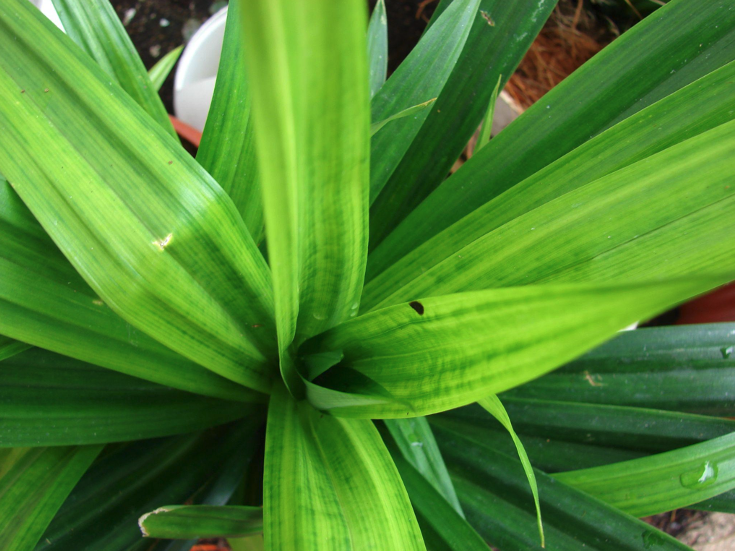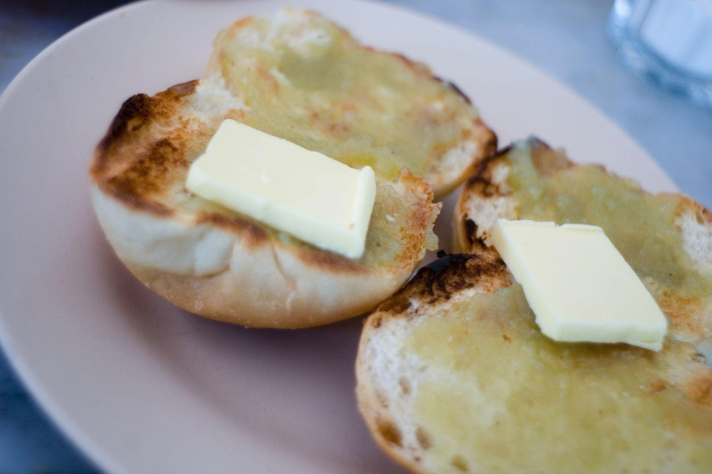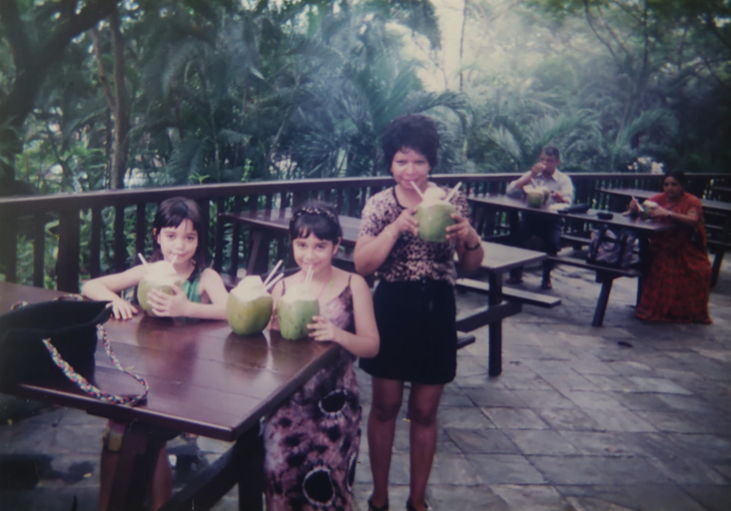Pandan / Pandanus amaryllifolius / Fiona Roberts
Pandan
Pandanus amaryllifolius
Fiona Roberts
My Favourite Plant: Pandan (Pandanus amaryllifolius)
My favourite plant, pandan (or Pandanus amaryllifolius) connects with memories that are special to me. Growing up in Southeast England, as a child I loved going back to Singapore to stay with my mother’s family during the summer. Some of my favourite memories were when my aunts would take my sister and me around the city for days out. Wherever we went - to the zoo, beach or science museum - we were always accompanied by a plastic bag from the bakery near their flat.
While watching the parrot show or dusting off sand after a swim, at some point during the day bread tinged with bright colours would emerge out of that bag. There was the reddish-purple surface of buns filled with red beans, others crystallized with grains of sugar, or my favourite: bread stained green from pandan leaves. These were kaya buns. Kaya is a sweet coconut jam made with pandan, which flavours it like vanilla and dyes it green. Added to simple bread, it oozes out when bitten into or torn gently by an aunt.

Figure 1: Pandanus amaryllifolius leaves. Photo by: Forest and Kim Starr.
Pandan is an ancient cultivated species in Southeast and South Asia, no longer known in the wild, often found trimmed into a small shrub with long, pleated leaves (National Parks Board Singapore 2019; Plants of the World Online 2019; Wakte et al. 2012). One of the only scented types of 750 Pandanus species, the unique taste which reminds me so strongly of childhood trips to the zoo, comes from a popcorn-fragranced chemical compound. This is 2-acetyl-1-pyrroline, also found in white bread, bread flowers, and basmati and jasmine rice (Global Biodiversity Information Facility 2019; Harrison and Dake 2005; National Parks Board Singapore 2019). The most significant ethnobotanical use of pandan is culinary, where juice extracted from leaves fragrances tea and desserts - like kaya buns - and its lush chlorophyll pigments food green.
During our trips, we’d always have toast spread with kaya jam in the mornings, and we’d take a jar or two back home to continue our breakfast for a while. When I grew older and started cooking for myself in London, I’d be happy to find pandan leaves frozen in shops selling imported products. Opening up the packet, I would find the pleated leaves neatly folded after their journey, and I added them to rice and baked desserts. For some reason, more than any other plant, it feels like an anchor to Singapore and my memories.

Figure 2: Kaya buns at a Singaporean bakery, Chin Mei Chin Confectionery. Photo by: Jonathan Lin.
As well as in kaya jam or baked into sweets, adding a twist of pandan leaves to ordinary rice can infuse the missing 2-acetyl-1-pyrroline compound, making it similar to basmati or jasmine rice which naturally contains this. The Malay dish nasi lemak adds pandan's fragrance by steaming rice and coconut milk with it, while in Indonesia, rice is steamed in baskets woven from the leaves (National Parks Board Singapore 2019; Wakte et al. 2009). Other phytochemical compounds able to treat diabetes and with potential anti-viral effects make it important in traditional medicine too (Ooi and Ooi 2004; Peungvicha et al. 1998). Equally, the same popcorn-like compound that is so delicious to humans, is used as an environmentally-friendly way to repel cockroaches (Li and Ho 2003).
Considering these qualities - the plantiness (Head et al. 2012) of pandan - makes me wonder why it’s the plant that feels most connected to my memories. Is it something about pandan’s unique planty qualities - its biophysical properties that provide its colour, taste and smell - that makes it so important? I'll continue to mull this over while cooking and enjoying its grassy, sweet taste.

Figure 3: The author (left) with her family at Singapore Zoo, 1997. Photo: Fiona Roberts.
Literature
Global Biodiversity Information Facility. 2019. Pandanus amaryllifolius Roxb. ex Lindl. Available at: www.gbif.org/species/9296315. (Accessed: 18 July 2023).
Harrison, T. and Dake, G. 2005. An Expeditious, High-Yielding Construction of the Food Aroma Compounds 6-Acetyl-1,2,3,4-tetrahydropyridine and 2-Acetyl-1-pyrroline. Journal of Organic Chemistry, 70(26), pp. 10872-10874. doi:doi/10.1021/jo051940a.
Head, L., Atchinson, J. and Gates, A. 2012. Ingrained: A Human Bio-geography of Wheat. London: Routledge.
Li, J. and Ho. S. 2003. Pandan leaves (Pandanus amaryllifolius Roxb.) as a natural cockroach repellent. Proceedings of the 9th National Undergraduate Research Opportunities Programme National University of Singapore, pp. 9-13.
National Parks Board Singapore. 2019. Pandanus amaryllifolius Roxb. Available at: www.nparks.gov.sg/florafaunaweb/flora/2/2/2299. (Accessed: 18 July 2023).
Ooi, L., Sun, S. and Ooi, V. 2004. Purification and characterization of a new antiviral protein from the leaves of Pandanus amaryllifolius (Pandanaceae). The International Journal of Biochemistry and Cell Biology, 36, pp. 1440-1446.
Peungvicha, P., Thirawarapan, S. and Watanabe, H. 1998. Possible mechanism of Hypoglycemic Effect of 4-Hydroxybenzoic Acid a Constituent of Pandanus odorus root. Journal of Ethnopharmacology, 62, pp. 395-398.
Plants of the World Online. 2019. Pandanus amaryllifolius Roxb. Ex Lindl. Available at: www.plantsoftheworldonline.org/taxon/urn:lsid:ipni.org:names:670690-1. (Accessed: 18 July 2023).
Wakte, K., Nadaf, A., Thengane, R. and Jawali, N. 2009. Pandanus amaryllifolius Roxb. cultivated as a spice in coastal regions of India. Genetic Resources and Crop Evolution, 56(5), pp. 735–740. doi:10.1007/s10722-009-9431-5.
Wakte, K., Zanan R., Saini, A., Jawali, N., Thengane, R. and Nadaf, A. 2012. Genetic diversity assessment in Pandanus amaryllifolius Roxb. populations of India. Genetic Resources and Crop Evolution, 59(7), pp. 1583-1595. doi:10.1007/s10722-012-9882-y.
About the author

Fiona Roberts is a collaborative PhD student at Cardiff University and Amgueddfa Cymru-National Museum Wales. Fiona has a BSc in Anthropology from University College London and following this, worked in the fundraising team for the Indigenous rights campaigning charity Survival International. She has an MSc in Ethnobotany from the University of Kent, where her dissertation focused on migration and culinary plant use in London‚ Singaporean and Malaysian diaspora. Her PhD research investigates decolonial and more-than-human approaches to biocultural curation, focusing on the colonial and postcolonial transfer of culinary spices, knowledge and practices from South and Southeast Asia to Wales, inspired by her mixed Singaporean/Anglo-Indian and British heritage.
You can reach her on Twitter at ;@FionaRoberts91 and RobertsFA2@cardiff.ac.uk.
The Society for Ethnobotany is open to researchers, practitioners, and enthusiasts of ethnobotany and economic botany.
The 2026 SEB Annual Meeting will take place in Montpellier, France, from May 31-June 4th!
If you have an interest in ethnobotany or economic botany you can become a member of the Society for Ethnobotany.
If you are a member of the Society for Ethnobotany and would like to contribute a Favorite Plant please contact Blair Orr, blairorr@ymail.com. (Note: ymail, not gmail.)
